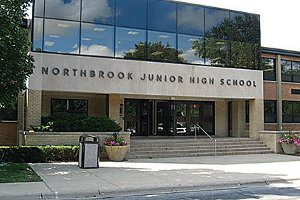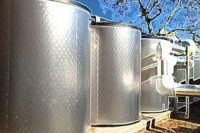A quiet learning environment, consistent comfort, and energy efficiency topped the list of requirements at Northbrook Junior High School in selecting chillers as part of a $1.88 million life-safety improvement renovation project. The two-story, 135,000-sq- ft school was originally built in 1958 and now serves 650 students in grades six through eight. The renovation project included replacement of all heating and cooling system components.
“We had a building with nine additions over the years and a severe overheating issue,” says Russ Jensen, director of buildings and grounds for Northbrook School District 28.

|
|
This junior high school uses 25% less energy thanks to new high-efficiency chillers. |
SHHHH! CHILDREN LEARNING!
With the priorities of quiet comfort and energy efficiency in mind, the project renovation team selected the McQuay WMC magnetic bearing compressor chiller with its industry leading efficiency and ultra-quiet operation. McQuay WMC chillers have the quietest sound levels in the industry with sound pressure ratings as low as 77 dBA per ARI Standard 575.
“The biggest selling factor for me in selecting the two 170-ton McQuay WMC chillers was the noise factor. The chiller plant is located next to three classrooms in the lower level so the equipment had to be quiet,” says Jensen. His views are echoed by John Kluber, partner with architectural-engineering firm Kluber Skahan and Associates in Batavia, IL. “You can’t have noise and vibration in schools with classrooms so close to the chiller plant.”
Kluber first saw the McQuay WMC chiller technology several years ago and knew it was right for the Northbrook project because McQuay WMC chillers effectively handle variable flow. This capability was important because the school was converting from a primary-secondary pumping scheme to a more efficient variable primary pumping system during the renovation.
Jensen said, “The technology of McQuay WMC chillers and the high level of McQuay service reinforced our decision to change the system design. We were able to proceed with a primary pumping system in a two-pipe configuration.” He says the former system required more pumps with each new building addition that was constructed over the years. A total of 26 pumps were removed in the renovation since the new system requires only one main pump and a back-up pump.
As part of the retrofit the old natural gas direct-fired absorber was removed and replaced with the two electric McQuay chillers. The building’s original boiler was replaced with two high efficiency condensing boilers. “The old system used a piping loop for the cooling system tied into the heating system at the plant. We had two sources of heat in every classroom with one source of control,” Jensen says.
COMPLEX CONTROL SYSTEMS
The school renovation project also included the design and installation of a comprehensive BAS that controls everything from the indoor air environment to outside parking lot lights.
“One of the most challenging parts of the project involved integrating the building’s various control systems to communicate with each other,” says Chad Elliott, project manager with Premier Mechanical, Inc. in Addison, IL. The McQuay chillers, along with the cooling tower and pumps, are part of the chiller plant controller designed to optimize efficiency at different loading scenarios. The chiller plant controller in turn communicates with the BAS from TAC.
Elliott and the entire project team credit the fine work of temperature control contractor Precision Controls of Chicago for making the control systems integration work.
In addition to the system integration, Jensen and the school custodial team also appreciate the user-friendly touch screen operator panel on each McQuay chiller that makes it easy for them to monitor chiller operating conditions at a glance.
TIGHT FITS AND TIGHT SCHEDULES
The compact design of the McQuay frictionless chillers was a key factor in the timely completion of the renovation. The project had a tight timeline for removal of old equipment, installation, and commissioning of new equipment. “The tear-down started in late May and we worked through the summer to complete the project by the August 24, due date, which was driven by the start of the school year,” Elliott says.
All told, the system renovations brought Northbrook Junior High an estimated 18% reduction in annual energy cost per square foot in both electrical and gas usage. Kluber says the specific energy performance of the entire systems including cooling tower, pumps, and chillers was .38 kW/ton. He adds that the school’s electricity consumption actually decreased even though new electric chillers were added to the system.
Northbrook Junior High qualified for the EPA’s Energy Star rating for K-12 schools based on the 12-month period. To qualify for an Energy Star rating requires a rating of 75 or better for a source energy intensity of 147 kBtuh/sq ft/yr. Northbrook’s source energy intensity was determined to be 109 kbtuh/ft2 / yr. The school consumes 26% less energy when compared to others in size and location for a rating of 79, according to Kluber.




